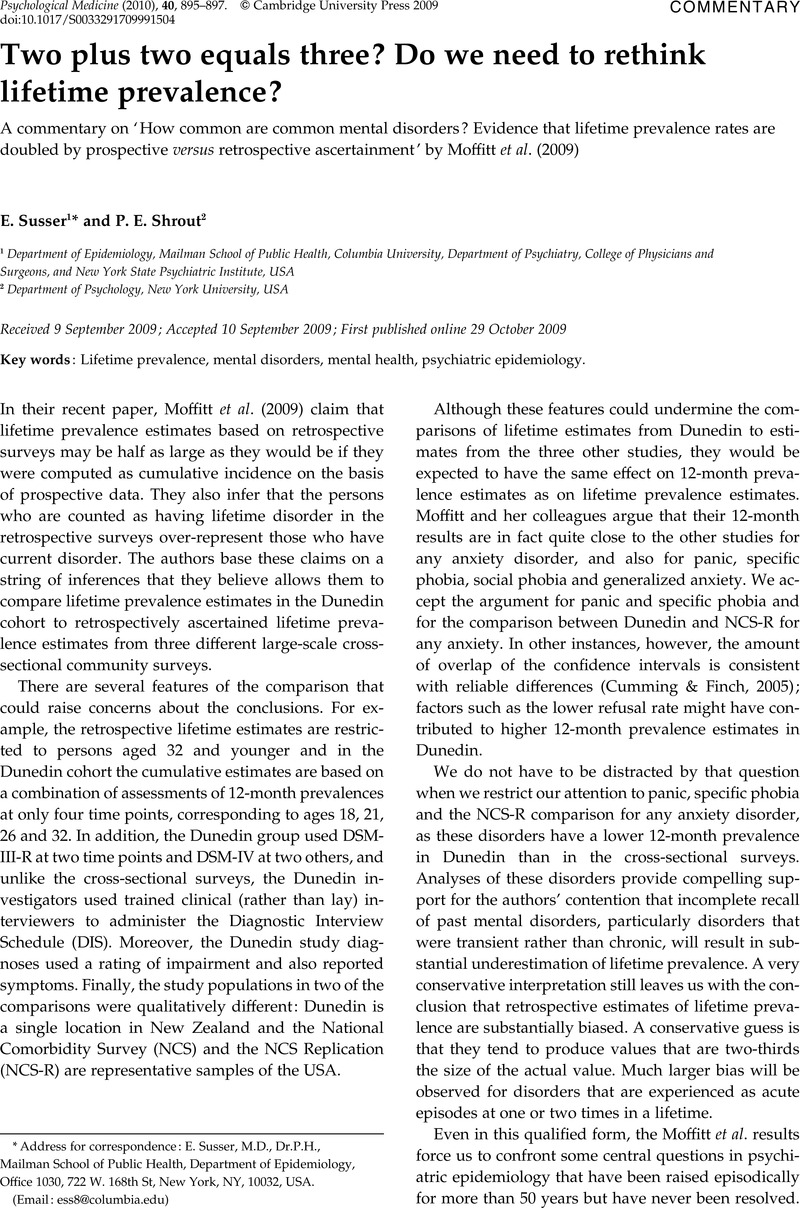Crossref Citations
This article has been cited by the following publications. This list is generated based on data provided by Crossref.
Saha, Sukanta
Scott, James
Varghese, Daniel
McGrath, John
and
Bell, Vaughan
2011.
The Association between Physical Health and Delusional-Like Experiences: A General Population Study.
PLoS ONE,
Vol. 6,
Issue. 4,
p.
e18566.
Ferrari, Alize J.
Baxter, Amanda J.
and
Whiteford, Harvey A.
2011.
A systematic review of the global distribution and availability of prevalence data for bipolar disorder.
Journal of Affective Disorders,
Vol. 134,
Issue. 1-3,
p.
1.
Rosenthal, Richard N.
Nunes, Edward V.
and
Le Fauve, Charlene E.
2012.
Implications of Epidemiological Data for Identifying Persons with Substance Use and Other Mental Disorders.
The American Journal on Addictions,
Vol. 21,
Issue. 2,
p.
97.
March, Dana
and
Susser, Ezra S.
2012.
Handbook of Community Psychiatry.
p.
21.
Erskine, Holly E.
Ferrari, Alize J.
Nelson, Paul
Polanczyk, Guilherme V.
Flaxman, Abraham D.
Vos, Theo
Whiteford, Harvey A.
and
Scott, James G.
2013.
Research Review: Epidemiological modelling of attention‐deficit/hyperactivity disorder and conduct disorder for the Global Burden of Disease Study 2010.
Journal of Child Psychology and Psychiatry,
Vol. 54,
Issue. 12,
p.
1263.
Ferrari, Alize J.
Charlson, Fiona J.
Norman, Rosana E.
Patten, Scott B.
Freedman, Greg
Murray, Christopher J.L.
Vos, Theo
Whiteford, Harvey A.
and
Hay, Phillipa J.
2013.
Burden of Depressive Disorders by Country, Sex, Age, and Year: Findings from the Global Burden of Disease Study 2010.
PLoS Medicine,
Vol. 10,
Issue. 11,
p.
e1001547.
Charlson, Fiona J.
Ferrari, Alize J.
Flaxman, Abraham D.
and
Whiteford, Harvey A.
2013.
The epidemiological modelling of dysthymia: Application for the Global Burden of Disease Study 2010.
Journal of Affective Disorders,
Vol. 151,
Issue. 1,
p.
111.
Ferrari, A. J.
Somerville, A. J.
Baxter, A. J.
Norman, R.
Patten, S. B.
Vos, T.
and
Whiteford, H. A.
2013.
Global variation in the prevalence and incidence of major depressive disorder: a systematic review of the epidemiological literature.
Psychological Medicine,
Vol. 43,
Issue. 3,
p.
471.
Ferrari, Alize J.
Charlson, Fiona J.
Norman, Rosana E.
Flaxman, Abraham D.
Patten, Scott B.
Vos, Theo
Whiteford, Harvey A.
and
Potash, James Bennett
2013.
The Epidemiological Modelling of Major Depressive Disorder: Application for the Global Burden of Disease Study 2010.
PLoS ONE,
Vol. 8,
Issue. 7,
p.
e69637.
Gyllenberg, David
Gissler, Mika
Malm, Heli
Artama, Miia
Hinkka-Yli-Salomäki, Susanna
Brown, Alan S.
and
Sourander, Andre
2014.
Specialized Service Use for Psychiatric and Neurodevelopmental Disorders by Age 14 in Finland.
Psychiatric Services,
Vol. 65,
Issue. 3,
p.
367.
Buka, Stephen L.
Viscidi, Emma W.
and
Susser, Ezra S.
2014.
Handbook of Epidemiology.
p.
2389.
Susser, E.
and
Patel, V.
2014.
Psychiatric epidemiology and global mental health: joining forces.
International Journal of Epidemiology,
Vol. 43,
Issue. 2,
p.
287.
Haeny, Angela M.
Littlefield, Andrew K.
and
Sher, Kenneth J.
2014.
Repeated Diagnoses of Lifetime Alcohol Use Disorders in a Prospective Study: Insights into the Extent and Nature of the Reliability and Validity Problem.
Alcoholism: Clinical and Experimental Research,
Vol. 38,
Issue. 2,
p.
489.
Erskine, Holly E.
Ferrari, Alize J.
Polanczyk, Guilherme V.
Moffitt, Terrie E.
Murray, Christopher J. L.
Vos, Theo
Whiteford, Harvey A.
and
Scott, James G.
2014.
The global burden of conduct disorder and attention‐deficit/hyperactivity disorder in 2010.
Journal of Child Psychology and Psychiatry,
Vol. 55,
Issue. 4,
p.
328.
Fernandez-Pujals, Ana Maria
Adams, Mark James
Thomson, Pippa
McKechanie, Andrew G.
Blackwood, Douglas H. R.
Smith, Blair H.
Dominiczak, Anna F.
Morris, Andrew D.
Matthews, Keith
Campbell, Archie
Linksted, Pamela
Haley, Chris S.
Deary, Ian J.
Porteous, David J.
MacIntyre, Donald J.
McIntosh, Andrew M.
and
Ebmeier, Klaus
2015.
Epidemiology and Heritability of Major Depressive Disorder, Stratified by Age of Onset, Sex, and Illness Course in Generation Scotland: Scottish Family Health Study (GS:SFHS).
PLOS ONE,
Vol. 10,
Issue. 11,
p.
e0142197.
Ferrari, Alize J
Stockings, Emily
Khoo, Jon‐Paul
Erskine, Holly E
Degenhardt, Louisa
Vos, Theo
and
Whiteford, Harvey A
2016.
The prevalence and burden of bipolar disorder: findings from the Global Burden of Disease Study 2013.
Bipolar Disorders,
Vol. 18,
Issue. 5,
p.
440.
Angst, J.
Paksarian, D.
Cui, L.
Merikangas, K. R.
Hengartner, M. P.
Ajdacic-Gross, V.
and
Rössler, W.
2016.
The epidemiology of common mental disorders from age 20 to 50: results from the prospective Zurich cohort Study.
Epidemiology and Psychiatric Sciences,
Vol. 25,
Issue. 1,
p.
24.
Erskine, Holly E.
and
Whiteford, Harvey A.
2018.
Epidemiology of binge eating disorder.
Current Opinion in Psychiatry,
Vol. 31,
Issue. 6,
p.
462.
Charlson, Fiona J
Ferrari, Alize J
Santomauro, Damian F
Diminic, Sandra
Stockings, Emily
Scott, James G
McGrath, John J
and
Whiteford, Harvey A
2018.
Global Epidemiology and Burden of Schizophrenia: Findings From the Global Burden of Disease Study 2016.
Schizophrenia Bulletin,
Vol. 44,
Issue. 6,
p.
1195.
Burrone, María Soledad
Alvarado, Rubén
Colantonio, Lisandro D.
Enders, Julio E.
Abeldaño Zuñiga, Roberto Ariel
Valencia, Eliecer
Susser, Ezra
and
Fernández, Ruth A.
2020.
Prevalence of Mood and Anxiety Disorders Among Adults Seeking Care in Primary Healthcare Centers in Cordoba, Argentina..
Frontiers in Psychiatry,
Vol. 11,
Issue. ,



